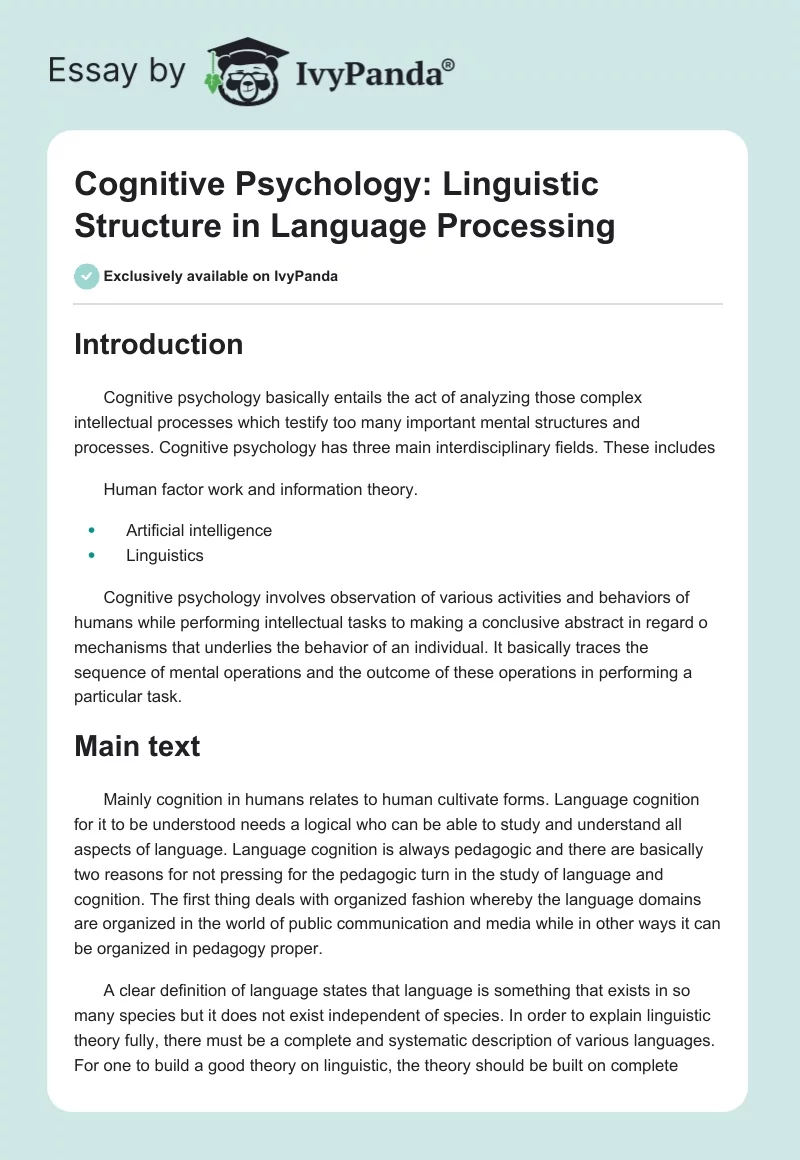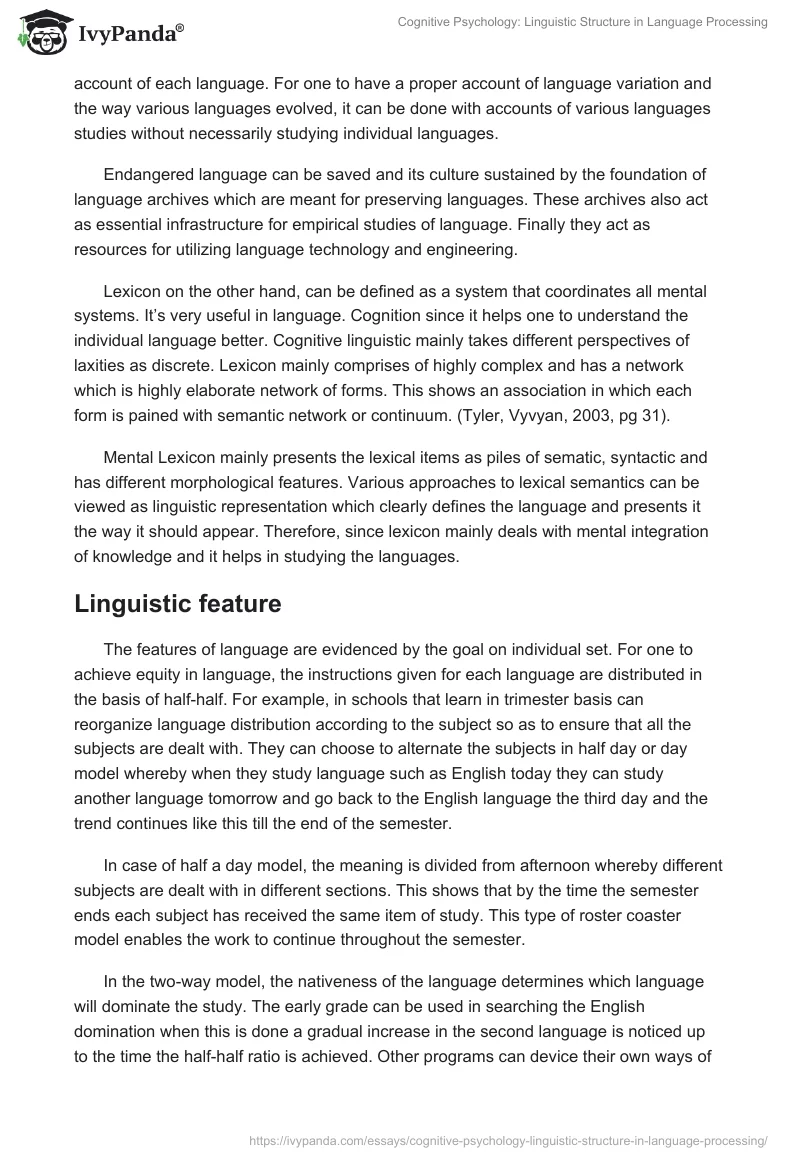Introduction
Cognitive psychology basically entails the act of analyzing those complex intellectual processes which testify too many important mental structures and processes. Cognitive psychology has three main interdisciplinary fields. These includes
Human factor work and information theory.
- Artificial intelligence
- Linguistics
Cognitive psychology involves observation of various activities and behaviors of humans while performing intellectual tasks to making a conclusive abstract in regard o mechanisms that underlies the behavior of an individual. It basically traces the sequence of mental operations and the outcome of these operations in performing a particular task.
Main text
Mainly cognition in humans relates to human cultivate forms. Language cognition for it to be understood needs a logical who can be able to study and understand all aspects of language. Language cognition is always pedagogic and there are basically two reasons for not pressing for the pedagogic turn in the study of language and cognition. The first thing deals with organized fashion whereby the language domains are organized in the world of public communication and media while in other ways it can be organized in pedagogy proper.
A clear definition of language states that language is something that exists in so many species but it does not exist independent of species. In order to explain linguistic theory fully, there must be a complete and systematic description of various languages. For one to build a good theory on linguistic, the theory should be built on complete account of each language. For one to have a proper account of language variation and the way various languages evolved, it can be done with accounts of various languages studies without necessarily studying individual languages.
Endangered language can be saved and its culture sustained by the foundation of language archives which are meant for preserving languages. These archives also act as essential infrastructure for empirical studies of language. Finally they act as resources for utilizing language technology and engineering.
Lexicon on the other hand, can be defined as a system that coordinates all mental systems. It’s very useful in language. Cognition since it helps one to understand the individual language better. Cognitive linguistic mainly takes different perspectives of laxities as discrete. Lexicon mainly comprises of highly complex and has a network which is highly elaborate network of forms. This shows an association in which each form is pained with semantic network or continuum. (Tyler, Vyvyan, 2003, pg 31).
Mental Lexicon mainly presents the lexical items as piles of sematic, syntactic and has different morphological features. Various approaches to lexical semantics can be viewed as linguistic representation which clearly defines the language and presents it the way it should appear. Therefore, since lexicon mainly deals with mental integration of knowledge and it helps in studying the languages.
Linguistic feature
The features of language are evidenced by the goal on individual set. For one to achieve equity in language, the instructions given for each language are distributed in the basis of half-half. For example, in schools that learn in trimester basis can reorganize language distribution according to the subject so as to ensure that all the subjects are dealt with. They can choose to alternate the subjects in half day or day model whereby when they study language such as English today they can study another language tomorrow and go back to the English language the third day and the trend continues like this till the end of the semester.
In case of half a day model, the meaning is divided from afternoon whereby different subjects are dealt with in different sections. This shows that by the time the semester ends each subject has received the same item of study. This type of roster coaster model enables the work to continue throughout the semester.
In the two-way model, the nativeness of the language determines which language will dominate the study. The early grade can be used in searching the English domination when this is done a gradual increase in the second language is noticed up to the time the half-half ratio is achieved. Other programs can device their own ways of language policy for mathematic and literature or else they deviate from a half-half basis after elementary school.
Incase someone enters the classroom and he or she is not familiar with the language that other students are using, the teacher is advised to train this individual outside the classroom up to the time he/she will catch up with other students. While giving instructions on the language, teachers are advised to use different colors, markers or chalks for each language so that it can be better understood. They are also advised to display and organize literature in the classroom so that different languages are distinguished.
Simultaneous translation of language should be avoided. Mainly the teacher does this if he/she realizes bewilder ness in students’ faces. Teachers should learn to stick on the long-term language learning process since this will increase devotion of students’ translation decreases the effectiveness of education.
In language instruction approaches, should be organized which helps in acquisition and learning. Teachers should learn to use verbal and non verbal cues, visual aids and manipulations which support the learning. Teachers are also advised to approach the language using content area which is manly to create context for language use. Skills such as listening, reading and writing should be integrated for effective language activity.
Another feature of language is decoding and encoding which signifies whether the students have received the message correctly.
Social Cultural features
This basically deals with minority language and the English which mainly meant for alleviation of social stigma which shows how well an individual can express themselves and their intelligence. Students are authorized to express themselves in the minority language in order to display their competence. This helps students to see others as human beings who have developed cognitively socially and linguistically. This is mainly meant for promoting cultural and linguistic diversity and to protect the minority culture among the students. The following critical features should be incorporated in reaching to promote cultural values.
Original work from the world of language minority groups should be included so that the children can view authors or intellectual models.
Teachers should learn to acknowledge what children bring to class for example, their life experience, cultural ways so as to build legitimate knowledge.
Home knowledge should be incorporated in learning.
Classrooms should be organized on high expectations in order to overcome the challenges of social expectations in children with minority language.
Pedagogical features
This feature involves committing parents in development of children’s language by attending to the unique needs of minority language. Its main aim is to have all the children reaching the highest levels of their language. This feature involves dual language which ensures that many considerations are made on children’s developmental needs, structuring the language and delivering instructions appropriately.
Language structure is greatly influenced by language processing.
There are various levels of structure of languages and processing
Structure of printed word – could come to learn while he/she is equipped with knowledge this child can purse the written words in parallel manner.
Internal structure of rime portion of syllable which can be with regard to inflectional ending. These people depend on the consonant that follows the vowel. In different study nasal basically shows the degree of cohesiveness and obstruent. This can show the weakest bond in consonant and vowel.
Synaptic structure- These are for incoming sentences, these are not deliverable from principle or other domains. Syntactic structure due processed by an autonomous processing system known as parser.
Structure of syllable: This is mainly re-integrated in phonological theory. This can help to distinguish two competing syllables. The syllable is not an internal structure of the language. Syllables can be divided into two units hierarchically i.e. use of terminology and Hailer consonant cluster of a syllable. (Carlson, Tanenshus, 1980, pg 19)
In analyzing the language, it has greatly enabled the cognitive psychologist to go through the prevailing behavior concept. Psychologists therefore, can be able to deal with different behaviors of individuals and the can help them to go through them. Behavioral concepts dealt with in this case are those which are not capable of explaining complexities.
Language also helps in cognitive processes since it helps in creating learning and implementing various rules. It also helps in relating to various issues of globalization diversity.
Languages as inmate capacity greatly contribute to development field of cognitive psychology. Language acts as one of the branches of cognitive psychology.
Therefore the study of language in this case helps greatly in understanding cognitive physiology, since language acts as the basic standard in cognitive psychology.
Reference
Andrea Tyler, Vivyan Evans, (2003), The Sematic of English Prepositions: Spatial Scenes Embodied, Cambridge University Press: United State.
Greg N. Carison, Michael K.Tanenhaus, (1989), Linguistic Structure in Language Processing, Springer: United State. Web.


